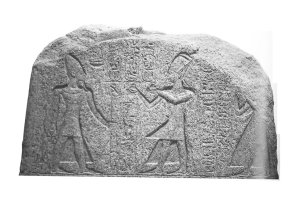During most of the time the Israelites were in Egypt, from about 1665 BC to 1450 BC, the country was divided. Native Egyptian rulers only controlled the southern part of the country, which, oddly enough (to us Americans), was called Upper Egypt. Their capital was at Thebes. Lower (northern) Egypt was under Hyksos control, and their gods were the ones worshipped by the Semitic inhabitants of the Levant and Mesopotamia.

We don’t know whether the Hyksos were still around at the time of the Exodus. At some point, probably while the Israelites were still living in Goshen in the Nile Delta, an Egyptian king decided he’d had enough and brought an army north to drive the Hyksos out of the land. The revolution began under Seqenenre Tao, whose badly battered mummy shows that he probably lost his last battle against the Hyksos. His sons, Kamose and Ahmose, carried on the fight, with Ahmose finally driving out the hated Asiatics after a war that appears to have lasted for at least twenty years.
You’ve noticed the similarity between the names of Seqenenre’s sons and Moses. Yes, Moses is an Egyptian name.
It appears the Hyksos left Avaris under a negotiated truce, but Ahmose apparently changed his mind about the deal. He chased the Hyksos toward Canaan, catching up with them at a Hyksos stronghold called Sharuhen, a town either in the Negev Desert, south of Israel, or near Gaza. (Joshua 19:6 puts it in the territory of the tribe of Simeon.) After a three-year siege, Ahmose took the town and razed it, ending Canaanite political influence in Egypt once and for all.
As best we can tell, it appears the principalities and powers who influenced the Hyksos brought them to Egypt at precisely the time of the Israelites’ sojourn, and everything else that happened, including the war for Egyptian independence, was part of a bigger plan: Genocide, something the house of Israel has survived many times now.
Consider: Just as Joseph was kidnapped by traders and carried off to Egypt, laying the groundwork for his family to follow and grow into a nation, a group of Jacob’s Semitic-speaking, Baal-worshiping neighbors also arrived in Egypt and took over the government from the natives.
Coincidence?
No. Analyzing history through a biblical lens, the Second Intermediate Period in Egypt was apparently a plan by the Fallen to bring a specific group to power in the land where Yahweh had led the Israelites. The purpose was to destroy the people that God had chosen for Himself.
Regardless of how it started, the long war between the native Egyptians in the south and the foreign Hyksos in the north would explain why the Israelites fell out of favor. If power changed hands from Semitic overlords to native Egyptian kings, the Semitic-speaking Hebrews would have been seen as potential enemy collaborators. The narrative in Exodus fits the political situation of the mid-fifteenth century BC.
Now there arose a new king over Egypt, who did not know Joseph. And he said to his people, “Behold, the people of Israel are too many and too mighty for us. Come, let us deal shrewdly with them, lest they multiply, and, if war breaks out, they join our enemies and fight against us and escape from the land.”
Exodus 1:8-10 (ESV)
Scholars disagree over which Egyptian king was the pharaoh of the Exodus, although the traditional candidate, Ramesses II (better known as Ramesses the Great, or Yul Brynner if you’re old enough to remember the movie), is incorrect. Ramesses lived and ruled about two hundred years later, between 1279 BC and 1213 BC.
Dr. Douglas Petrovich wrote a 2006 paper that convinced us that the Exodus should be dated to 1446 BC, just as the Bible records, and that Amenhotep II, who reigned 1455–1418 BC, was the pharaoh who had to be compelled by God to let His people go.[1]
It may seem counterproductive for Baal to lead the Hyksos into Egypt, set them up as kings, and then allow them to be run off again by native Egyptians within a hundred years or so. But the Egyptians’ hatred of the Hebrews was a byproduct of the Hyksos intervention. Besides, despite what you’ve seen in movies over the years, the worship of Baal and other Semitic gods continued in northern Egypt long after the Hyksos were driven out.
During the reign of the Hyksos, Baal was identified with the god Set, the Egyptian god of storms, chaos, the desert, and foreigners, which was a good fit with Baal, apparently. The Hyksos adopted Set and blended the two into a single entity—Baal-Set.
Today, we think of Set, sometimes called Seth or Sutekh, as an evil god who chopped his brother Osiris into fourteen pieces. He was usually depicted as a bizarre character with a human body and an anteater-like head. But Set wasn’t always a villain. In the time of the Hyksos, and for a few centuries after, Set helped the sun god, Ra, by defeating the evil serpent Apep/Apophis, the embodiment of chaos, which tried to eat Ra’s solar boat every night as it disappeared over the horizon. In this tale, Set’s nightly victory over Apep echoed the Semitic myth in which Baal vanquished the chaos god of the sea, Yam, and his sea-dragon servant, Lotan.
Points to you if you noticed the similarity between the name Lotan and the Bible’s Leviathan. It’s a classic PSYOP by the Fallen, claiming the deeds of Yahweh as their own.
When Apophis delayed Ra’s boat, there were storms; when he ate it, there was an eclipse. But the victories of Apophis were always temporary, and every evening Set was back on the front of the boat to spear the serpent.
Later in Egyptian history, though, after being conquered by the Nubians, Assyrians, and Persians one after another between 800 BC and 525 BC, the god of foreigners was no longer welcome around the pyramids. That’s why later Egyptians considered Set evil.
The worship of Baal-Set continued in northern Egypt for at least four hundred years, long after the Hyksos were run out of the country. In fact, the pharaohs of the Ramesside dynasty were worshipers of Baal-Set. The father of Ramesses the Great was named Seti I, which means “man of Set.” Several other kings of the Ramesside period, including Seti II and Setnakht (“Set is strong”), were also named for the god.
There is some speculation that because Ramesses the Great was a redhead (true fact!), his family may have been descendants of the Hyksos invaders. Whatever the reason, Ramesses II set up a stela at Pi-ramesses, near the site of the old Hyksos capital Avaris, that portrays Seti I offering wine to Set. The god is depicted like the Canaanite images of Baal, with a human head instead of the more familiar anteater-head from later Egyptian history.
Since the stela points back four hundred years to about 1650 BC, it could mark the arrival of Baal-Set in the Nile Delta. Counting back 215 years from the Exodus date of 1450 BC, this is just about the time Jacob and the family arrived in Egypt. Coincidence?
When Yahweh led the Israelites out of Egypt, He ordered them to turn around and camp on the shore of the Red Sea facing something called Baal-zephon. Why? So they’d cross the Red Sea right in front of it.
Here’s the funny part: As worshipers of the desert-god Set, the Egyptian army probably thought they had the Israelites right where they wanted them.
For Pharaoh will say of the people of Israel, ‘They are wandering in the land; the wilderness has shut them in.’
Exodus 14:3 (ESV)
Caught in front of Baal-zephon between areas controlled by their god, Baal-Set, master of the sea and god of the desert—the Egyptians must have figured the Israelites were hopelessly trapped!
Which brings us back to our earlier question: What was Baal-zephon, and why was it so important? Why did God tell Moses to turn around, so this confrontation happened right there?
Here’s why: The name of Baal’s holy mountain, which is more than five hundred miles north of the Nile delta, was Mount Zaphon.
Do you see the significance? The Red Sea crossing was a supernatural smackdown! Baal was the god of storms, the god who vanquished the primordial chaos-god of the sea, Yam. Because of this, Baal was the patron god of sailors for centuries.
So, Yahweh didn’t just deliver the Israelites “out of the hand of pharaoh,” He delivered them out of the hand of Baal! And to make sure nobody misunderstood the message, He did it in front of a site dedicated to Baal, and by mastering the sea—Baal’s domain.
The confrontation at the Red Sea was engineered by Yahweh to serve notice to the Fallen: My people are freed from their bondage and now we are coming for you.
That was the reason for the crossing. Yahweh used it to demonstrate His power, yes, but for a specific purpose—to make it crystal clear to the Israelites that I AM was unparalleled, unchallenged, and sovereign. It was a demonstration of His authority over the divine entities who’d chosen to abuse the responsibilities He’d given them after Babel.
And it was a clear message to the gods that the days of their rebellion were numbered.
[1] Douglas Petrovich, “Amenhotep II and the Historicity of the Exodus-Pharaoh.” The Master’s Seminary Journal, 17:1, 1–30.

